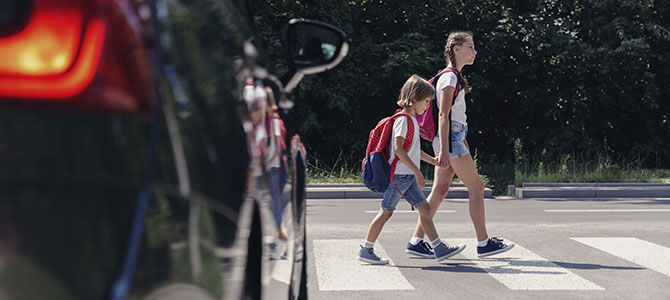
Back-to-school pedestrian and road safety tips: Little feet and busy streets
With school starting up and back-to-school routines resuming, our streets and sidewalks are about to get a lot busier. Whether it’s students walking, riding their bikes, taking the bus, or being driven to school, it’s important to keep traffic safety in mind and remain alert while you commute.
Over the last year, we've been working hard to deliver transportation upgrades aimed at improving safety. These include:
- More than 380 new or replaced curb ramps
- 37 pedestrian signals modified to be fully accessible
- 13 new rectangular rapid flashing beacons to enhance safety at marked crosswalks
- Three new full traffic signals
- Nine new walking and cycling signals
- 113 intersections adjusted for slower walking speeds
- Eight new leading pedestrian intervals (where people walking get to move before motor vehicles)
Tips to help keep everyone safe as we head into fall
Driving safety
- Watch for people walking, rolling and cycling and be aware of what you can’t see due to shadows or obstructions.
- When in doubt, slow down – reducing your speed allows you to stop faster and greatly reduces the likelihood of serious injury or death in the case of a collision with someone walking, rolling, or cycling.
- Keep the area around your home and school a safe place to walk, cycle, and roll by following posted signs.
- Never pass a school bus when it’s picking up or dropping off kids.
- Remember 30 km/h school zones are back in effect. Drivers need to slow down to 30 km/h on residential streets adjacent to schools.
- Respect school pick-up and drop-off zones and time limits.
- Yield to pedestrians and remain stopped at every marked and unmarked intersection until pedestrians reach the other side of the curb – remember people walking have priority crossing the street at intersections.
- Be considerate and share the road with all other road users, particularly more vulnerable road users – people walking, rolling, and cycling.
Walking safety
- Be sure you’re seen - making eye contact with drivers is a good way to be sure drivers see you.
- Look both ways before you cross the street and cross at an intersection with a pedestrian crossing light whenever possible.
- Your hearing can help you identify hazards – be particularly careful when wearing headphones and put away phones or other gadgets when crossing the street – focus on the road.
Cycling safety
- Just as with walking, be sure you’re seen - making eye contact with drivers is a good way to be sure drivers see you.
- Use lights whenever it’s dark and always wear a helmet.
- Watch for people walking and don’t ride too close to them – what feels safe for you may feel dangerous to someone walking.
- Your hearing can help you identify hazards – removing headphones will help you hear what’s going on around you.
- Ride on the roadway, paths, or bike lanes – don’t ride on the sidewalk.
We launched our first Slow Zone neighbourhood pilot in the Grandview-Woodland area in March 2021, reducing speed limits to 30km/h, down from 50km/h, and since May, we’ve designated a further 40km with simple traffic barriers and signs to make roads even safer for pedestrians as part of our Slow Streets initiative.
In spring 2021, we piloted the School Streets program in partnership with VSB in an effort to reduce vehicle congestion around schools and to improve air quality. A car-free block was created beside three elementary schools (Lord Roberts Elementary, Van Horne Elementary and Hastings Elementary), where only biking, walking, and rolling were allowed during pick-up and drop-off times. The program will continue for the duration of the 2021-22 school year.
Resources
- Back to School Safety PDF file (325 KB)
- Slow Zone Neighbourhood Pilot
- Slow Streets Pilot
- Visibility and safety tips
Quotes
Mayor Kennedy Stewart
“Road safety is one of our top priorities and is a shared responsibility,” said Mayor Kennedy Stewart, City of Vancouver “We live in a big, beautiful, bustling city and rely on the community to do their part to achieve our goal of eliminating traffic-related fatalities and injuries on Vancouver streets. When everyone is considerate and patient with other people the city is a safer space for everyone.”
